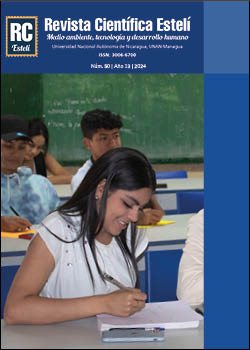Risk Probabilities of Mercury Exposure in Fishing Communities in the Great Lakes Basin of Nicaragua
DOI:
https://doi.org/10.5377/esteli.v13i50.18482Keywords:
Exposure, lake, mercury, fish, riskAbstract
Environmental contamination by mercury (Hg) is highly toxic and results in the detriment of aquatic ecosystems, as well as in negative effects on human health. The objective of this research was to demonstrate the risk probabilities that the fishing communities of the Great Lakes of Nicaragua have when consuming fish with Hg from these ecosystems. For this purpose, it was necessary to diagnose the presence of mercury in Lake Cocibolca. Between January and June 2022, water and sediments were collected from the lake, fish were acquired from local fish stocks, Hg levels in water, sediments and fish were analyzed, and surveys were applied to four communities in the Great Lakes basin to obtain information on fish consumption and anthropometric data for risk analysis. The results show a low bioavailability of Hg in the Great Lakes of Nicaragua, however, the Hg content of the fish analyzed is higher than that of fish from non-polluted environments (<0.008) mg/kg. The Hg content in fish (0.008 to 0.475) mg Hg/kg is significantly lower (p<0.0001, α =0.05) in Lake Cocibolca. Fortunately, the risk probabilities associated with fish consumption are low (<4.4%) for the studied communities in the Lake Cocibolca basin. However, the risk probabilities for the fishing communities of the Lake Xolotlán basin suggest monitoring the safety, in terms of Hg content, of these hydrobiological resources.
Downloads
316
HTML (Español (España)) 164
Published
How to Cite
Issue
Section
License
Copyright (c) 2024 Revista Científica de la FAREM-Estelí

This work is licensed under a Creative Commons Attribution-NonCommercial-ShareAlike 4.0 International License.
© Revista Científica de FAREM-Estelí

